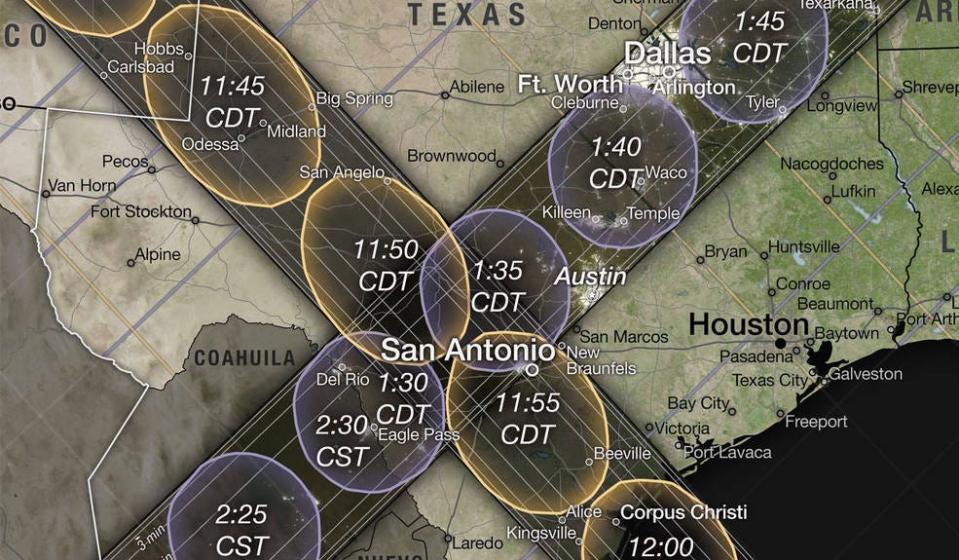Corpus Christi will be among the best places to see the 'ring of fire' solar eclipse
One of the biggest shows in the skies is on its way – and Corpus Christi is among the cities that will have a special, front-row seat for a solar eclipse known as the “ring of fire.”
Come Saturday, most of the U.S. will be able to view at least a partial eclipse – but what will be visible in Corpus Christi will appear as the outermost, circular edges of the sun, its center blotted out by the moon passing between the sun and earth below.
In short, it will appear as a ring.
Here’s what to expect.
What is a ring of fire eclipse?
A ring of fire eclipse is known more formally as an annular eclipse – based on the Latin word “annulus,” meaning ring.
For Lord of the Rings fans, one comparison could be made to the Eye of Sauron, said Dr. Chuck Blend, a parasitologist and the vice president of the Corpus Christi Astronomical Society.

When will I see it?
The show gets underway mid-afternoon Saturday.
Starting around 10:30 a.m., people looking up will “start seeing the first inklings of the eclipse,” Blend said.

“It will look like something is slowly taking bigger and bigger round bites out of the pie in the sky – the sun,” he said. “That will be the moon as it is slowly moving between the earth and the sun.”
Around 11:55 a.m., the eclipse will reach maximum annularity – the height of occlusion — for roughly five minutes, Blend said.
How can I see it?
Experts say you can never, ever look directly at the sun without risking serious, irreversible damage – and traditional sunglasses just won’t cut it.
The only safe option – other than a pinhole projector or camera – is to purchase special eclipse-viewing glasses that can adequately protect your eyes.
Although some organizations holding special events will give them out for free, the best bet may be to order them online.
Be sure to check the label – it should show an ISO icon and an ISO reference number 12312-2, according to the Austin American-Statesman.
They shouldn’t have damage – including tears or scratches – or be made before 2015, according to a news release issued by the city of Corpus Christi.
A way to check if they pass the test?
You should see absolutely nothing when looking through them, Blend said.
“If you see any light at all in those glasses, then they’re not up to snuff,” he said.
Where to see it
Although area parks are expected to be among the most popular places to take in the sight, they’re also anticipated to be packed if not entirely booked.
Be sure to check any requirements or availability of passes before heading out.
There’s not a need, though, to go to a specific place to see it.
It will be visible throughout the area, including your own home’s backyard, Blend said.
Who's coming to the party
There’s not an estimate yet on exactly how many people will travel to the Coastal Bend to catch what is anticipated to be a spectacular sky.
Recent data provided by Visit CC – the local version of the Convention and Visitors Bureau – shows a 55% increase in reservations for the upcoming weekend compared to last year.
Billing it as a “space meets the shore” experience, representatives anticipate the event as being a “significant draw for tourism,” according to a news release.
Officials “are looking forward to celebrating the darkness,” wrote Brett Oetting, Visit Corpus Christi president and CEO in the press release.
“Over the last decade, the tourism industry has seen huge increases in visitation from around the world for these unique events,” he wrote.
How's the weather looking?
Corpus Christi’s National Weather service is forecasting what may be an ideal day for outdoor viewing – clear and sunny.
The extended forecast – subject to change as the weekend nears – on the agency’s website shows a cool front moving in from Friday to Saturday, with a high of 80 degrees to 85 degrees Saturday and a low of 65 degrees to 75 degrees.
Planned events
A number of events are planned around the Coastal Bend, but here are two expected to bring large crowds.
Corpus Christi Museum of Science and History
As part of its Valero Eclipse Extravaganza, activities planned at the museum include “STEM-focused experiments and demonstrations including solar ovens, solar slime, galaxy jars, and chemistry ice cream,” according to the museum’s website.
There will also be solar eclipse glasses for the first 1,100 guests, the website states.
When: 10 a.m. to 5 p.m.
Where: The Corpus Christi Museum of Science and History, 1900 N. Chaparral St.
City of Corpus Christi
To be held the night before the solar eclipse, the event will include distribution of free solar eclipse glasses (while supplies last), discussions on the significance of the upcoming eclipse and food trucks.
When: 5:30 p.m. to 8 p.m. Friday
Where: Cole Park Pier Plaza, 1900 Ocean Dr.
More: Next solar eclipse will be visible over US in fall 2023: Here's where you can see it
More: Apollo 11 moon landing anniversary: How Corpus Christi helped make history
More: NASA: 7 under-the-radar facts about Corpus Christi's ties to space travel
This article originally appeared on Corpus Christi Caller Times: corpus christi one of best places to see October 2023 solar eclipse

